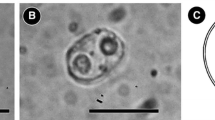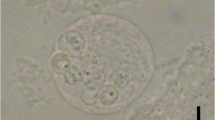Abstract
A new myxosporean parasite, Zschokkella candia n. sp., from the gall-bladder of the wild parrotfish Sparisoma cretense (L.) (Perciformes: Scaridae) is described based on light and scanning electron microscopy. Mature spores are elliptical, with mean dimensions 11.2 ± 0.5 × 7.8 ± 0.1 μm and possess spherical polar capsules with mean diameter of 2.3 ± 0.3 μm. The new species is differentiated from other similar species of the genus based on spore morphology, its coelozoic life-style and molecular data. The phylogenetic tree constructed using maximum likelihood analysis of small subunit (SSU) rDNA sequence data complements the characterisation of Zschokkella candia n. sp. by defining its phylogenetic position among the species of Zschokkella Auerbach, 1909 sequenced to date. The phylogenetic analysis supports the existing knowledge on the complicated polyphyletic relationships among the members of the genus Zschokkella.



Similar content being viewed by others
References
Ali, M., Abdel-Baki, A. A., & Abdel-Ghaffar, F. (2007). Zschokkella egyptica n. sp. (Myxosporea: Bivalvulaida) infecting the gallbladder of the eel catfish Plotosus lineatus Thunberg, 1787 and the freckled goatfish Upeneus tragula Richardson, 1846 in the Red Sea, Egypt. Parasitology Research, 100, 625–628.
Davies, A. J. (1985). Zschokkella russelli Tripathi (Myxozoa: Myxosporea) from the five-bearded rockling, Ciliata mustela L., (Teleostei: Gadidae) in Wales. Journal of Fish Diseases, 8, 299–308.
Diamant, A., & Paperna, I. (1992). Zschokkella icterica sp. nov. (Myxozoa, Myxosporea), a pathogen of wild rabbitfish Siganus luridus (Ruppell, 1829) from the Red Sea. European Journal of Protistology, 28, 71–78.
Diamant, A., Lom, J., & Dyková, I. (1994). Myxidium leei n.sp., a pathogenic myxosporean of cultured sea bream Sparus aurata. Diseases of Aquatic Organisms, 20, 137–141.
Fiala, I. (2006). The phylogeny of Myxosporea (Myxozoa) based on small subunit ribosomal RNA gene analysis. International Journal for Parasitology, 36, 1521–1534.
Fiala, I., & Bartoŝová, P. (2010). History of myxozoan character evolution on the basis of rDNA and EF-2 data. BMC Evolutionary Biology, 10, 228.
Freeman, M. A., Yokoyama, H., & Ogawa, K. (2008). Description and phylogeny of Ceratomyxa anko sp. n. and Zschokkella lophii sp. n. from the Japanese anglerfish, Lophius litulon (Jordan). Journal of Fish Diseases, 31, 921–930.
Hall, B. G. (1999). BioEdit: A user-friendly biological sequence alignment editor and analysis program for Windows 95/98/NT. Nucleic Acids Symposium Series, 41, 95–98.
Heiniger, H., & Adlard, R. D. (2014). Relatedness of novel species of Myxidium Bütschli, 1882, Zschokkella Auerbach, 1910 and Ellipsomyxa Køie, 2003 (Myxosporea: Bivalvulida) from the gall bladders of marine fishes (Teleostei) from Australian waters. Systematic Parasitology, 87, 47–72.
Heiniger, H., Gunter, N. L., & Adlard, R. D. (2008). Relationships between four novel ceratomyxid parasites from the gall bladders of labrid fishes from Heron Island, Queensland, Australia. Parasitology International, 57, 158–165.
Hervio, D. M. L., Kent, M. L., Khattra, J., Sakanari, J., Yokoyama, H., & Devlin, R. H. (1997). Taxonomy of Kudoa species (Myxosporea), using a small subunit ribosomal DNA sequence. Canadian Journal of Zoology, 75, 2112–2119.
Holzer, A. S., Wootten, R., & Sommerville, C. (2010). Zschokkella hildae Auerbach, 1910: Phylogenetic position, morphology, and location in cultured Atlantic cod. Parasitology International, 59, 133–140.
Kalatzis, P. G., Kokkari, C., & Katharios, P. (2013). Description and relationships of two novel species of Ceratomyxa Thelohan, 1892 infecting the gallbladders of Aulopiformes: Atlantic lizardfish Synodus saurus Linnaeus, 1758 and royal flagfin Aulopus filamentosus Bloch, 1792 from Cretan Sea, Greece. Parasitology Research, 112, 2055–2061.
Kaspiris, P. (2000). The fish of Greece (Identification keys) (p. 242). Patra: University of Patras.
Katharios, P., Garaffo, M., Sarter, K., Athanassopoulou, F., & Mylonas, C. C. (2007). A case of high mortality due to heavy infestation of Ceratomyxa diplodae in sharpsnout sea bream (Diplodus puntazzo) treated with reproductive steroids. Bulletin of the European Association of Fish Pathologists, 27, 43–47.
Katharios, P., Kokkari, C., Sterioti, A., Smyrli, M., & Kalatzis, P. G. (2014). Enteromyxum leei infection in parrotfish, Sparisoma cretense: Histopathological, morphological and molecular study. Veterinary Parasitology, 199, 136–143.
Lom, J., & Arthur, J. R. (1989). A guideline for the preparation of species descriptions in Myxosporea. Journal of Fish Diseases, 12, 151–156.
Lom, J., & Dyková, I. (1992). Protozoan parasites of fishes (p. 315). New York: Elsevier.
Molnár, K. (1994). Comments on the host, organ and tissue specificity of fish myxosporeans and on the types of their intrapiscine development. Parasitologia Hungarica, 27, 5–20.
Molnár, K. (2002). Site preference of myxosporean spp. on the fins of some Hungarian fish species. Diseases of Aquatic Organisms, 52, 123–128.
Molnár, K., Székely, C., Hallett, S. L., & Atkinson, S. D. (2009). Some remarks on the occurrence, host-specificity and validity of Myxobolus rotundus Nemeczek, 1911 (Myxozoa: Myxosporea). Systematic Parasitology, 72, 71–79.
Nielsen, C. V., Køie, M., Székely, C., & Buchmann, K. (2002). Comparative analysis of SSU rRNA genes from Myxobolus aeglefini Auerbach, 1906 isolated from cod (Gadus morhua), plaice (Pleuronectes platessa) and dab (Limanda limanda), using PCR-RFLP. Bulletin of the European Association of Fish Pathologists, 22, 201–205.
Rigos, G., Grigorakis, K., Christophilogannis, P., Nengas, I., & Alexis, M. (1997). Ceratomyxa spp. (myxosporea) infection in cultured common dentex from Greece. Bulletin of the European Association of Fish Pathologists, 17, 174–176.
Sarkar, N. K. (2012). Three new species of Myxosporea (Bivalvulida), parasites of the gallbladder of scombrid fish, from the Bay of Bengal (Indian Ocean), West Bengal, India. Protistology, 7, 172–177.
Stamatakis, A., Hoover, P., & Rougemont, J. (2008). A rapid bootstrap algorithm for the RAxML Web-Servers. Systematic Biology, 75, 758–771.
Tamura, K., Stecher, G., Peterson, D., Filipski, A., & Kumar, S. (2013). MEGA6: Molecular Evolutionary Genetics Analysis version 6.0. Molecular Biology and Evolution, 30, 2725–2729.
Thompson, J. D., Gibson, T. J., Plewniak, F., Jeanmougin, F., & Higgins, D. G. (1997). The CLUSTAL X windows interface: Flexible strategies for multiple sequence alignment aided by quality analysis tools. Nucleic Acids Research, 25, 4876–4882.
Thorsen, D. H., Mille, K. J., Van Tassell, J. L., & Hajagos, J. G. (2000). Infestation of the parrotfish Sparisoma cretense (Scaridae) by the fish louse Anilocra physodes (Isopoda: Cymothoidae) in the Canary Islands. Cybium, 24, 45–59.
Whipps, C. M., Adlard, R. D., Bryant, M. S., Lester, R. J. G., Findlay, V., & Kent, M. L. (2003). First report of three Kudoa species from eastern Australia: Kudoa thyrsites from mahi mahi (Coryphaena hippurus), Kudoa amamiensis and Kudoa minithyrsites n. sp. from sweeper (Pempheris ypsilychnus). Journal of Eukaryotic Microbiology, 50, 215–219.
Yemmen, C., Marton, S., Bahri, S., & Eszterbauer, E. (2013). Morphology, seasonality and phylogeny of Zschokkella soleae sp. n. (Myxozoa, Myxosporea) parasite of Solea solea (L.) (Pleuoronectiformes, Soleidae) from Ghar El Melh Lagoon, Tunisia. Journal of Fish Diseases, 36, 871–879.
Acknowledgements
We would like to thank Mrs. Alexandra Siakouli - Galanopoulou, from the Electron Microscopy Laboratory of the University of Crete for her valuable assistance and advice on the SEM analysis.
Author information
Authors and Affiliations
Corresponding author
Ethics declarations
Conflict of interest
The authors declare that they have no conflict of interest.
Ethical approval
All applicable institutional, national and international guidelines for the care and use of animals were followed.
Rights and permissions
About this article
Cite this article
Kalatzis, P.G., Kokkari, C. & Katharios, P. Morphological characterisation and phylogenetic relationships of Zschokkella candia n. sp. from the gall-bladder of Sparisoma cretense (L.) (Perciformes: Scaridae) in the Sea of Crete off Greece. Syst Parasitol 92, 211–218 (2015). https://doi.org/10.1007/s11230-015-9594-8
Received:
Accepted:
Published:
Issue Date:
DOI: https://doi.org/10.1007/s11230-015-9594-8




